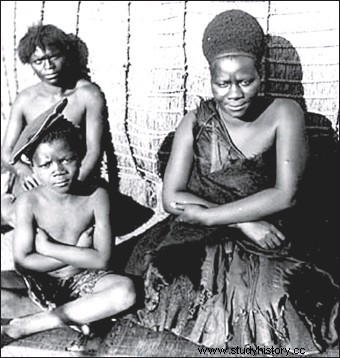Queen-consort, queen-mother then regent of Swaziland, Labotsibeni Mdluli or Gwamile (circa 1859 – 1925) ruled and protected his kingdom at a time when European settlers were snapping up South Africa.
Gwamile , the indomitable
 Daughter of Matsanjana Mdluli, Labotsibeni Mdluli was born around 1859 in northern Swaziland. It was born under the reign of Mswati II, at a time when Boers, British and Portuguese colonized South Africa and triggered violent conflicts with its inhabitants. Boer settlers took a keen interest in the fertile lands of Swaziland, causing conflict as early as 1852.
Daughter of Matsanjana Mdluli, Labotsibeni Mdluli was born around 1859 in northern Swaziland. It was born under the reign of Mswati II, at a time when Boers, British and Portuguese colonized South Africa and triggered violent conflicts with its inhabitants. Boer settlers took a keen interest in the fertile lands of Swaziland, causing conflict as early as 1852.
After the death of her father, Labotsibeni was placed under the guardianship of Queen Mother Tsandzile Ndwandwe, mother of Mswati II. With her uncle Mvelase Mdluli, she settled in the royal village of Ludzidzini in northern Swaziland. This is an opportunity for her to observe the court and learn about politics.
On the death of Mswati II in 1868, a period of regency began during which Queen Tsandzile Ndwandwe managed the kingdom. His eldest son Ludvonga II was to take over, but he died of poisoning before he could access the throne. It was his son Mbandzeni who, in 1875, became king under the name of Dlamini IV. Shortly after, Labotsibeni, nicknamed Gwamile (the indomitable) for her strong character, became one of the wives of the new king. Labotsibeni has four children with her husband:a daughter, Tongotongo, and three sons, Bhunu, Malunge and Lomvazi.
Ndlovukazi, queen mother
In the 1880s, the discovery of gold at Barbeton led to a rush of European settlers on the lands of Swaziland. While the fighting and conquering King Mswati II led Swaziland to its greatest territorial expansion, Dlamini IV proved permissive and reckless. He thus allows the creation on his lands of a Boer republic, the Klein Vrystaat ("small free state"). Dlamini IV grants land concessions and monopolies, sometimes competing and inconsistent, leading to numerous disputes as well as the departure of some of his subjects.
The king died young, in 1889; his eldest son Bhunu succeeded him as Ngwane V, and Labotsibeni Mdluli became Ndlovukazi, Queen Mother. It is then the old queen-mother, Tibati, mother of Dlamini IV, who exercises the regency. Labotsibeni, for his part, became more and more involved in politics and tensions grew between the two queens, until the death of Tibati in 1895.
Labotsibeni had already revealed herself as the more powerful of the two. In 1894, it notably imposed itself in the negotiations around the third convention on Swaziland in 1894, making Swaziland a protectorate of the Transvaal. The position of the Queen Mother, whose authority is represented on the royal coat of arms of Swaziland by an elephant, is reinforced by the behavior of her son. Accused of murder, he fled with his brother Malunge, escaped prison but was forced to return to Swaziland. Although found not guilty, King Ngwane V is stripped of his powers as paramount chief.
Boer War
In 1899, when the Second Boer War broke out between Boers and the British, the South African Republic left Swaziland and returned its authority to Ngwame, but he died two months later. Labotsibeni Mdluli then ensures the regency for his six-month-old grandson Mona, who will become king under the name of Sobhuza II.
During the war, although Swaziland was part of the British Empire, Labotsibeni endeavored to preserve the neutrality of his kingdom and to maintain diplomatic relations with both sides. At the end of the war, the regent and her council wanted Swaziland to become a British protectorate, but it was management of the kingdom by the Transvaal that was looming. Labotsibeni protests, sends delegations and exerts political pressure; the territory will eventually be placed under the authority of the British Governor of Bechuanaland and Basutoland.
The disputes inherited from the multiple concessions granted by Dlamini IV during his reign continue to pose problems, and lead to a partition of the lands which Labotsibeni opposes in vain. A third of the land goes to the British crown, a second third is granted to private settlers and the last third goes to the Swazi nation.
Last acts of a regent
In 1910, the Union of South Africa was founded as a dominion of the British Crown; Swaziland is not included, nor are Basutoland and Bechuanaland. Worried about the rise of this powerful neighbour, in the hands of white settlers, the regent supports and funds the South African Natives National Congress , a political organization intended to represent the black community.
During World War I, Labotsibeni Mdluli refused to send Swazi men to fight in Europe. Despite this resistance, it was instead forced to contribute financially to the war effort.
Labotsibeni promotes education in particular for the future leaders of the country, and in particular of his grandson who is to inherit the throne. She sends him to Lovedale School in Alice, South Africa, accompanied by eight young men and three young women. When she deems him ready, she takes him out of school. In December 1921, she passed on the crown to him.
Labotsibeni Mdluli died in December 1925.
